Remember when “digital transformation” meant setting up a company Facebook page? Good times. Now we’re watching AI reshape entire industries, and if your organization is still stuck in the “let’s form a committee to explore AI possibilities” phase, I’ve got some sobering news: the gap between AI leaders and laggards is widening faster than your IT department’s backlog.
While executives debate whether ChatGPT is a security risk, 65% of organizations are already using generative AI in at least one business function—nearly double from last year’s 33%. Overall AI adoption has jumped to 72%, after being stuck at around 50% for six years.
BUT here’s what’s happening in the real world of AI adoption right now: Most companies are completely unprepared for the acceleration we’re witnessing. They’re setting up governance committees and running pilot projects as if they have years to figure this out. They don’t.
The Uncomfortable Truth About Industry Adoption
I recently analyzed comprehensive data across major industries, and the numbers reveal something fascinating: AI isn’t just being implemented—it’s fundamentally transforming how business gets done. The transformation potential varies dramatically by sector, with banking showing a remarkable 72% of working hours having automation potential, followed closely by insurance at 68%. Retail operations aren’t far behind with 40-50% of tasks that could be enhanced or automated through AI. Perhaps most striking is manufacturing, where 75% of advanced manufacturers are now prioritizing AI as a competitive necessity rather than a future possibility.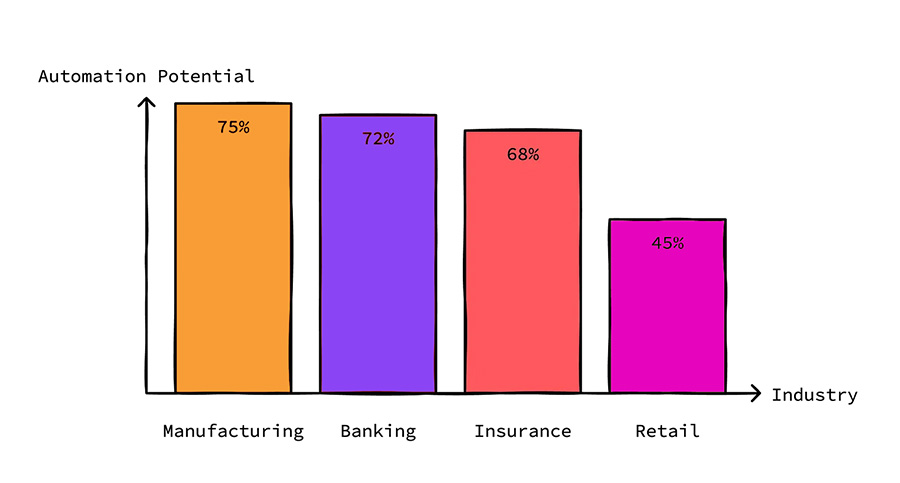
These aren’t speculative projections—they’re happening now. And while your IT department is still debating which chatbot to pilot, your competitors are already seeing tangible results.
The average company implementing AI is reporting a 15.2% revenue boost. That’s not rounding error territory—that’s the kind of number that determines who survives the next economic downturn.
What AI Champions Are Actually Doing in Each Industry
Let’s cut through the hype and look at where the real work is happening across major sectors. This isn’t about futuristic robot assistants—it’s about practical applications creating measurable value today.
Financial Services: Beyond Chatbots
Financial institutions are transforming their operations through sophisticated AI applications that deliver measurable results. Advanced fraud detection systems now analyze millions of transactions in real-time, comparing each against evolving behavioral patterns and identifying anomalies that human analysts might miss. According to Quokka Labs, these systems have helped major banks reduce fraud losses by over 20%, representing millions in savings annually. Similarly, risk assessment algorithms are revolutionizing lending by looking beyond traditional credit scores to analyze alternative data sources like rent payment history, employment stability, and even digital footprints—allowing banks to extend credit to previously underserved populations while maintaining sound risk profiles. Personalized finance tools leverage AI to analyze individual spending patterns, income timing, and financial goals to deliver tailored advice that feels like having a financial advisor in your pocket, significantly improving customer satisfaction and retention. Meanwhile, AI-powered compliance monitoring systems continuously scan communications, transactions, and documentation to automatically flag potential regulatory issues before they become problems, helping institutions navigate the complex regulatory landscape while reducing compliance staff workload by up to 40%.
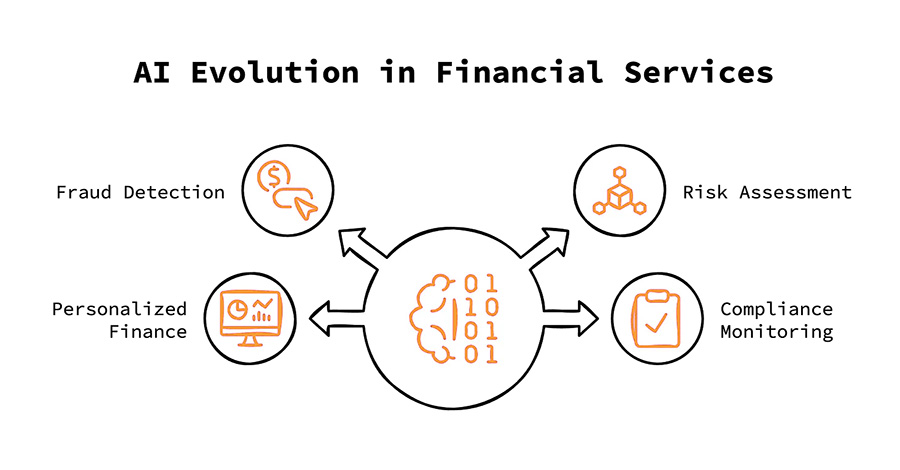
What’s most interesting is the scale of impact. Bank of America’s AI assistant Erica now serves over 10 million users, while AT&T’s AI fraud detection system reduced iPhone fraud by more than 80%.
The innovation isn’t slowing down either. Gartner expects over 80% of banks to be using generative AI by 2026, up from just 5% today. If you’re in financial services, this isn’t a “maybe someday” technology—it’s rapidly becoming table stakes.
Healthcare: From Admin to Clinical Applications
Healthcare has traditionally been cautious with new technology, and for good reason—lives are literally at stake. But the data shows adoption is accelerating rapidly:
- Over 70% of healthcare organizations are now pursuing or implementing generative AI capabilities
- 29% are actively investing in generative AI today, with another 56% planning to within three years
- Most healthcare facilities have been using some form of AI for at least 10 months according to Medscape and HIMSS
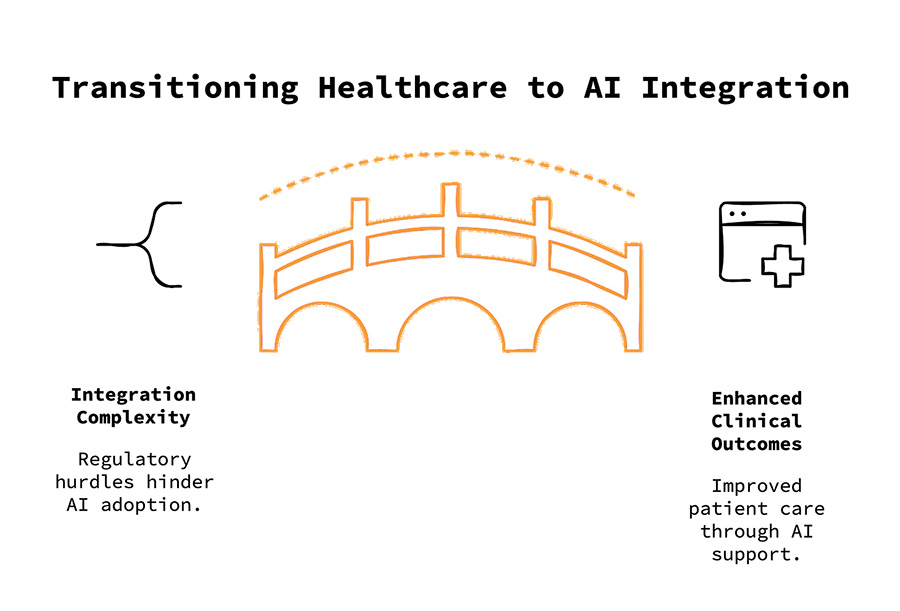
The applications are expanding beyond administrative tasks (though those remain important):
- Medical imaging analysis that helps radiologists detect anomalies faster and more accurately
- Predictive analytics that identify patients at risk for specific conditions
- Clinical decision support that helps doctors stay current with the latest research and treatment options
- Drug discovery acceleration that’s reducing research timelines by analyzing complex biological data
The challenge in healthcare isn’t skepticism anymore—it’s integration complexity, regulatory hurdles, and ensuring AI augments rather than replaces clinical judgment. As one healthcare executive told McKinsey, “We don’t need AI to replace doctors, we need it to help them be better doctors.”
Retail: The Personalization Revolution
Retail presents perhaps the widest adoption gap of any industry, creating both challenges and opportunities for forward-thinking professionals. While overall adoption sits at just 4% across the sector, the retailers who have embraced AI are experiencing transformative results that are reshaping competitive dynamics. According to Progressive Grocer, 69% of AI-implementing retailers report significant revenue increases—many seeing 10-15% growth in categories where AI drives merchandising and pricing decisions. Simultaneously, 72% have achieved substantial cost reductions through optimized inventory management and streamlined operations, with some cutting supply chain expenses by up to 30%. The momentum shows no signs of slowing, as NVIDIA’s recent survey reveals 86% of retailers plan to leverage generative AI specifically for enhancing customer experiences through personalized recommendations, conversational shopping assistants, and customized marketing messages. This gap between early adopters and the majority creates a remarkable competitive advantage window for retail professionals who move quickly to implement practical AI solutions while their competitors remain hesitant.
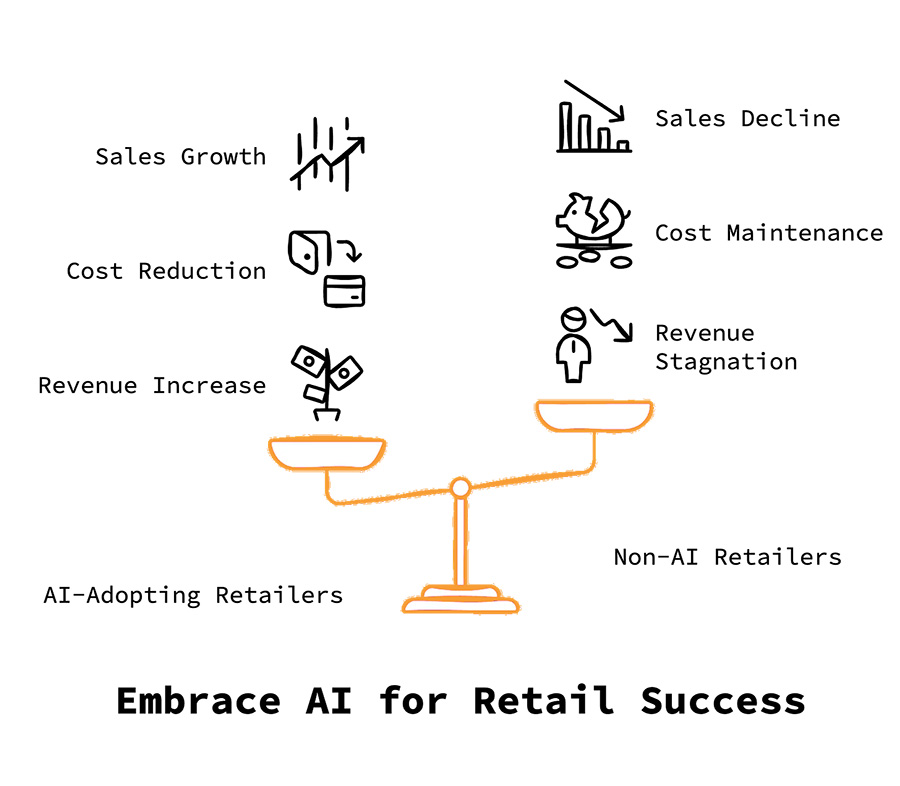
What Actually Works in Retail AI
The most successful retail AI implementations focus on:
- Inventory optimization that reduces stockouts and overstock situations by predicting demand patterns
- Dynamic pricing that adjusts based on demand, competition, and inventory levels
- Personalized marketing that targets customers with offers they’re likely to respond to
- Supply chain optimization that anticipates disruptions and adjusts accordingly
What’s most surprising is that after years of hype, AI in retail is actually delivering on its promises. Retailers who’ve implemented AI-driven forecasting have seen sales increases of up to 15% while simultaneously reducing inventory costs.
The gap between leaders and laggards in retail isn’t just about technology—it’s about mindset. Leaders view AI as a core business capability, not an IT project.
Manufacturing: The Quietly Revolutionary Sector
While tech companies get the headlines, manufacturing is quietly revolutionizing its operations with AI:
- 12% overall adoption rate, but 75% of advanced manufacturers now prioritize AI
- 84% expect digital transformation, including AI, to accelerate over the next decade
- The AI in manufacturing market is projected to reach $230.95 billion by 2034
The applications focus on concrete operational improvements that deliver measurable bottom-line impact across the manufacturing value chain.
Predictive maintenance stands at the forefront, with AI-powered systems continuously monitoring equipment through sensors that capture vibration, temperature, and performance data to identify potential failures days or weeks before they occur—according to an ASME blog post, companies implementing these systems can reduce unplanned downtime by up to 50% and extend machine lifespans by 20-40%. Quality control has been revolutionized through computer vision systems that can inspect thousands of products per minute with micron-level precision, detecting subtle defects invisible to the human eye while achieving consistency impossible for human inspectors who typically experience focus fatigue after 30-40 minutes. Production optimization algorithms ingest data from hundreds of variables—from energy usage to material properties to equipment settings—and continuously adjust manufacturing parameters to maximize output quality and quantity while minimizing resource consumption, with some facilities reporting 15-30% efficiency improvements. Supply chain management has perhaps the widest impact, with AI systems analyzing historical patterns, market signals, and even weather forecasts to improve demand forecasting accuracy by 30-50%, allowing manufacturers to reduce inventory costs while simultaneously decreasing stockout incidents and improving customer satisfaction through more reliable delivery timelines.
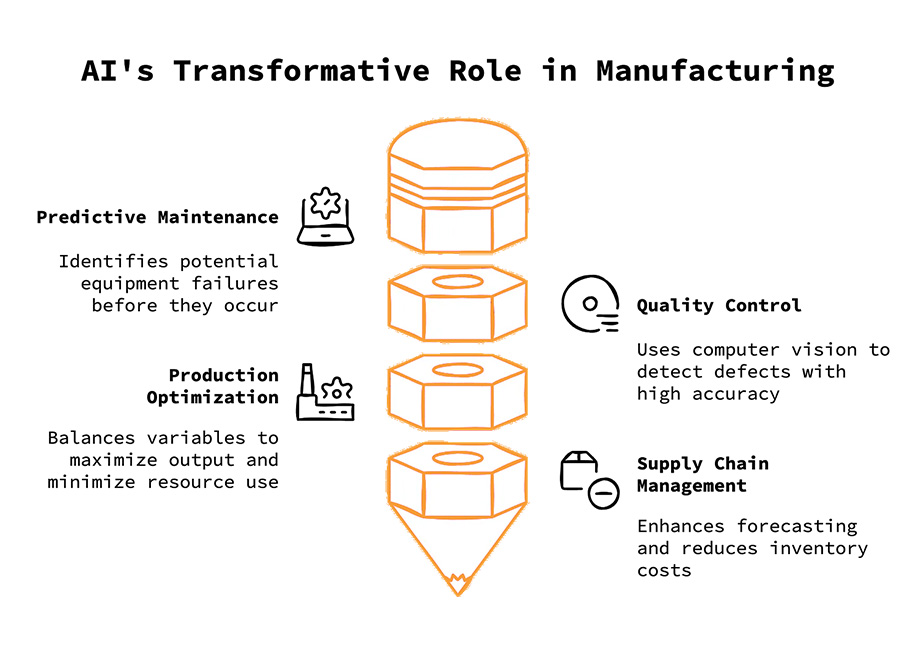
The companies seeing the greatest success aren’t treating AI as a standalone technology—they’re integrating it into their existing operational technology (OT) environment and using it to enhance their existing expertise.
As one manufacturing executive put it, “We’re not replacing our experienced maintenance technicians with AI. We’re giving them AI tools so they can focus on fixing problems instead of hunting for them.”
Insurance: The Risk Management Revolution
The insurance industry, traditionally conservative, is rapidly embracing AI with strategic intent. While current adoption is below 30%, Insurance Business America reports that 70% of insurers plan to implement advanced AI models utilizing real-time data within two years—one of the fastest adoption rates across industries. This shift is driven by necessity, with 77% of insurance executives recognizing AI as essential to remain competitive. Early adopters report tangible results, including 14% higher customer retention and 48% higher Net Promoter Scores, directly translating into profitability and growth.
AI is transforming historically labor-intensive and inefficient core processes. Claims processing now uses computer vision, natural language processing, and algorithms to reduce settlement times from weeks to hours, enhancing accuracy and consistency. Risk modeling has evolved significantly, with AI systems analyzing extensive data—from satellite images to driving telemetry—enabling precise policy pricing and broader coverage options. Advanced fraud detection identifies subtle connections between seemingly unrelated claims, saving billions annually. Additionally, customer service is increasingly personalized, anticipating client needs through conversational AI that offers immediate, tailored support.
![]()
Perhaps the most significant development is AI’s role in creating entirely new business models. Insurers are moving toward usage-based policies, pricing risks based on actual behaviors rather than demographic estimates. Auto insurers adjust premiums monthly based on real driving data, while home insurers use IoT sensors to proactively prevent damage, transforming insurance from a passive safeguard to active risk prevention. Health insurers incentivize wellness through wearable-tracked programs, lowering premiums as health targets are achieved. These innovations mark a fundamental shift toward proactive protection, driving insurers to rapidly integrate AI despite their historically cautious stance toward technological change.
Why Most AI Projects Fail: The Implementation Gap
Here’s the reality check: approximately 75% of non-leading businesses lack an enterprise-wide roadmap for AI integration, and less than 40% of senior leaders fully understand how the technology creates business value.
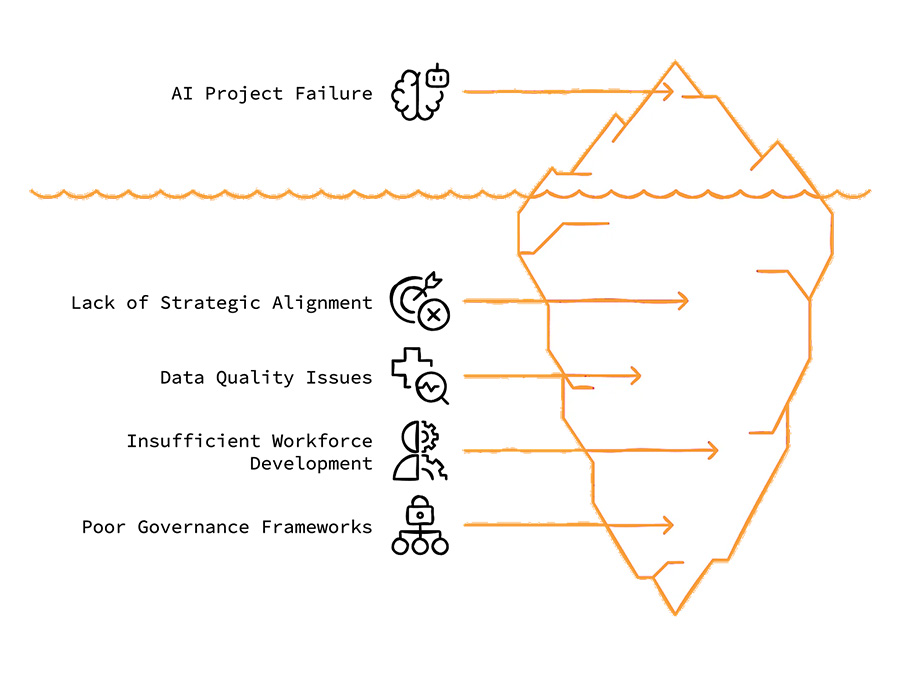
This explains why so many AI initiatives underperform. The key challenges include:
- Lack of strategic alignment between AI initiatives and business objectives
- Data quality issues that undermine algorithm effectiveness
- Insufficient investment in workforce development
- Poor governance frameworks around AI deployment and usage
The organizations succeeding with AI share several characteristics:
- They focus on value creation rather than technology implementation
- They invest heavily in reskilling their workforce
- They establish clear metrics for measuring AI success
- They approach AI as a business transformation, not just a technical challenge
As one researcher noted, “Despite the spike in adoption of generative AI, we are still in the experimentation phase, with many organizations seeking relatively simple, one-step solutions. This is a very natural tendency in the early days of a new technology, but it’s not a sound approach as generative AI becomes more widely adopted.”
What’s Actually Happening to Jobs?
Now let’s address the elephant in the zoom meeting: jobs. The data here might surprise you.
Rather than wholesale job replacement, AI is creating what researchers call the “missing middle”—a new space where humans and AI collaborate. The impact varies dramatically by job category:
- 9% to 63% of working hours are transformable across industries
- Five job categories exceed 50% transformation potential
- 97 million new jobs are expected to be created alongside 85 million potentially displaced jobs
How Jobs Are Changing (Not Disappearing)
The key insight is that AI is changing jobs rather than eliminating them entirely. For example:
- Customer service representatives are using AI to handle routine queries while focusing on complex issues
- Healthcare professionals are using AI for initial diagnostic screening while making final decisions
- Manufacturing technicians are using predictive maintenance AI to prioritize equipment repairs
The skills in demand are evolving accordingly:
- Data analysis abilities to interpret and act on AI-generated insights
- AI literacy to understand capabilities, limitations, and appropriate applications
- Creative problem-solving for situations where AI provides options but lacks contextual understanding
- Ethical AI management to ensure systems operate fairly and transparently
Organizations are responding with upskilling programs, but there’s a significant gap. Only 63% of companies offer comprehensive AI training, creating an opportunity for professionals who proactively develop these skills.
What Separates AI Champions from Everyone Else
After analyzing dozens of successful AI implementations across industries, clear patterns emerge that distinguish effective AI champions from those simply dabbling in the technology. These differentiators go beyond technical expertise to encompass strategic thinking, organizational approach, and measurement discipline.
![]()
AI champions approach integration strategically, viewing AI within entire value chains rather than isolated use cases. They connect AI across processes from customer acquisition to support, creating cohesive end-to-end efficiencies. Stanford research highlights this value-chain focus as critical for maximizing AI’s business value.
Successful AI adopters prioritize augmentation over replacement. Rather than viewing AI primarily as a cost-cutting measure, they see it as enhancing human capabilities. Robin Bordoli of Authentic Ventures emphasizes, “AI is about machines augmenting humans, not replacing them.” IBM’s Rob Thomas reinforces this, noting, “Managers who use AI will replace those who don’t.”
Champions skillfully balance immediate wins with strategic goals, combining quick successes that build momentum with long-term initiatives aimed at significant competitive advantage. This balanced approach sustains enthusiasm and drives ongoing transformation.
Investing significantly in workforce enablement, these organizations prioritize training, change management, and process integration—often more than technology itself. SHRM research underscores that successful AI adoption depends heavily on human factors and tailored workforce strategies.
Finally, effective AI adopters establish clear metrics and measure obsessively, refining their approach based on continuous feedback. Industry studies confirm that rigorous tracking of AI’s technical performance and business impact accelerates success and ensures ongoing improvement.
The Radical Idea of Sharing AI Gains With Your Team
While most companies view AI primarily as a cost-cutting tool, some forward-thinking organizations are taking a different approach. Rather than hoarding AI productivity gains, they’re sharing them with their teams through better compensation.
The strategy is beautifully simple: The more employees embrace and implement AI tools, the more their salaries grow.
This approach aligns employee and organizational interests, transforming potential resistance into enthusiasm for adoption. As one observer noted, “The future of work might not be humans vs AI. It might be humans + AI = prosperity for both.”
Your Window of Opportunity Is Narrower Than You Think
Most business leaders I speak with assume we’re in the early stages of AI adoption with plenty of time to adjust and find their place in the transformed landscape. The data suggests otherwise—we’re rapidly approaching an inflection point where AI capabilities and adoption will accelerate dramatically, creating both opportunities and risks for professionals and organizations.
I’m seeing three types of middle managers right now:
![]()
The champions aren’t just playing with the technology—they’re becoming indispensable translators between AI capabilities and business needs. And they’re positioning themselves for significant career advancement in the process.
The opportunity to establish yourself as an AI champion is closing faster than most realize. By this time next year, the organizations that haven’t made significant progress in AI implementation will be struggling to catch up, and the window for early career differentiation will have narrowed substantially.
The AI Champion’s Advantage
Beyond the immediate productivity gains, positioning yourself as an AI champion creates three career advantages that will compound over time:
- Visibility with Leadership: As executives grow increasingly concerned about AI implementation, your practical expertise will make you a go-to resource.
- Cross-Functional Value: You’ll develop relationships across departments as your frameworks can be applied widely.
- Future-Proofing: Rather than being replaced by AI, you’ll be the essential human who helps others implement it effectively.
In my AI Adopters community, I see these champions receiving more recognition, responsibility, and, in many cases, promotions and raises as their organizations recognize their value.
The question isn’t whether AI will transform your industry—the data shows that transformation is already well underway. The real question is whether you’ll be leading that transformation or playing catch-up.
Which path will you choose?


